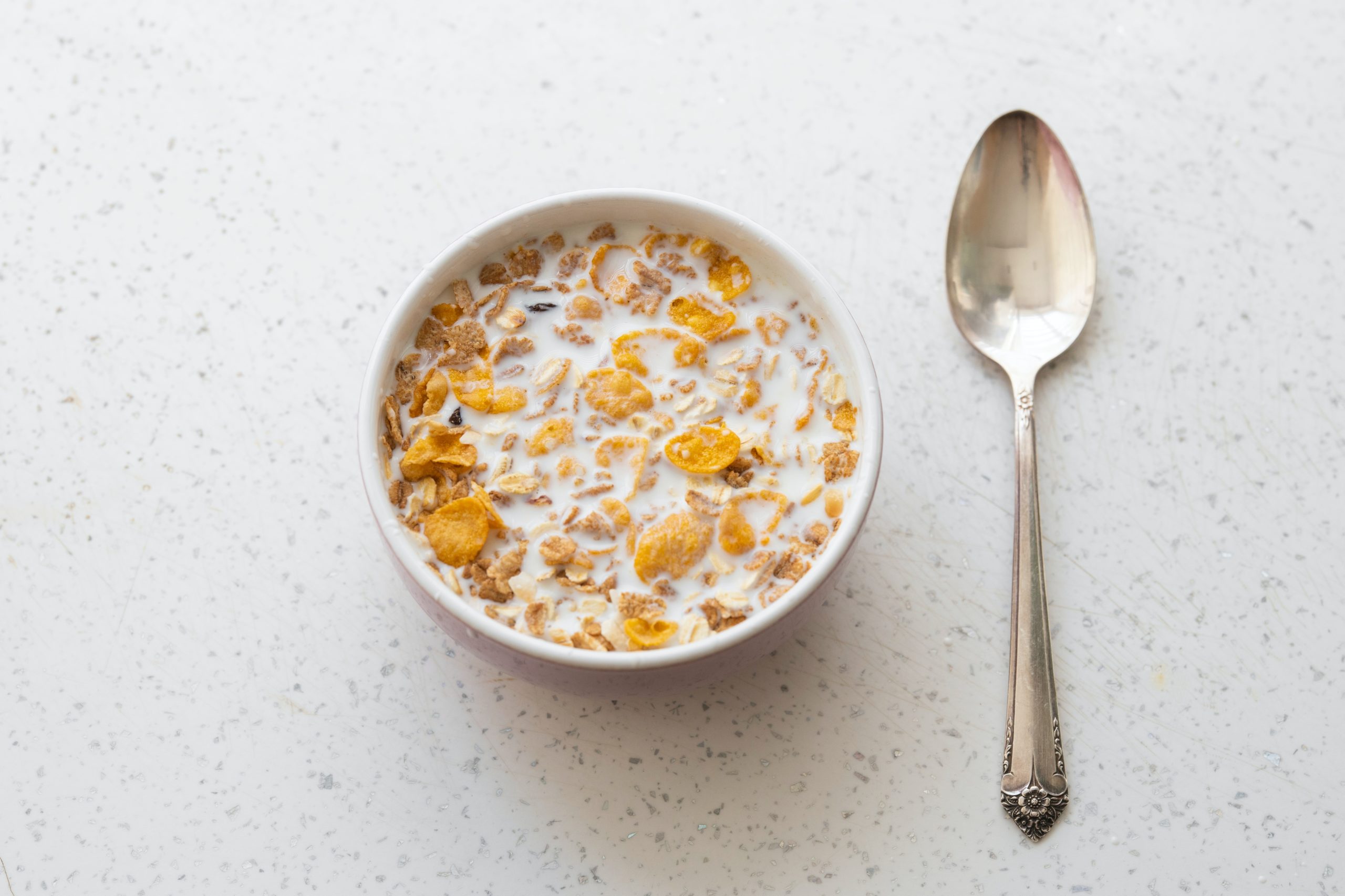
13 Jan Is Cereal For Breakfast Healthy?
Cereal is one of our nation’s most popular breakfasts, but should you eat cereal if you’re trying to lose weight? Is is a healthy, low calorie option? Or is it better avoided? Here, we’ll answer some of the most popular questions around whether cereal is good for you. We’ll also explore whether you can eat cereal for breakfast and still lose weight.
CAN YOU EAT BREAKFAST CEREAL AND STILL LOSE WEIGHT?
As a team of qualified, experienced nutritionists who specialise in weight loss, we do not recommend eating cereal for breakfast. Our colleagues all agree that cereal does not make for an optimal to the day.
Cereals are often high in sugar and starchy carbohydrates, while being low in protein and healthy fats. This means that it’s likely to set you off on a blood sugar rollercoaster and unlikely to keep you satisfied until lunchtime. The result? Energy dips and sugar cravings later in the day that will likely result in you snacking on foods that do not support your weight loss. More on this later.
Cereal is one of the most popular breakfast in the UK. Many of us were raised on cereal which can create an attachment to it and, with many of us leading busy lives, cereals take minimal time to prepare. But our country is facing an obesity crisis. Our rates of diabetes and other chronic, lifestyle related diseases are skyrocketing and processed breakfast cereals are not helping the problem. If you are committed to losing weight and leading a healthier lifestyle, you may want to reconsider your choice of breakfasts.
WHY IS CEREAL BAD FOR YOU?
Let’s start with the sugar content of cereal. It’s true that certain cereals do contain very high amounts of sugar. If a cereal says ‘sugar’ or ‘honey’ or ‘chocolate’ in the title, it may seem obvious that it’s going to be high in sugar. However, many cereals marketed as ‘healthy’ or ‘natural’, like mueslis and granolas, can contain significant amounts of sugar, providing several teaspoons per serving. It is always worth checking the label on the back of the packet rather than simply buying into the marketing messages on the front. If you’re not familiar with how to work out how much sugar is in your food, you can read our step by step guide here.
It’s also important to remember that, even if a cereal doesn’t contain a high amount of added sugar, most are still based on processed carbohydrates which break down into simple sugars and behave much the same way.
WHAT HAPPENS WHEN YOU EAT CEREAL FOR BREAKFAST?
Unfortunately, there are very real consequences of starting our day with a meal based on simple carbohydrates.
The glycemic index (GI) rates carbohydrate foods on how fast they break down into simple sugars. The glycemic index of glucose itself is 100, so the higher the GI of a food, the faster it breaks down into sugar. While cereals like Cornflakes and Rice Krispies don’t have a huge amount of sugar added to them, their starchy carbohydrates break down in just the same way. Both have a GI of over 70 classing them as ‘high GI’, with Cornflakes coming in at 81.
High GI carbohydrates cause a spike in our blood sugar levels. The body can only deal with so much sugar at once so what isn’t immediately used will be carried away and stored. Storage sites in the body include cells in the liver and muscles where sugar is stored as glycogen, and fat cells. Sugar and starchy carbohydrates are not your friends if you’re trying to lose weight or maintain your happy weight.
There are many other reasons why existing on a ‘blood sugar rollercoaster’, where your blood sugar level spikes and dips, is not good for health. It’s a primary contributor to diabetes and other chronic diseases.
Aside from the health consequences, meals like this are not going to help your energy levels or mental alertness either. When we experience the inevitable blood sugar dip that follows this spike, with it plummets our energy levels and ability to concentrate. Blood sugar dips can make us feel tired, hungry, grumpy and craving a sugar or carb fix to bring them back up.
We see this in children. They eat cereal for breakfast and it feels like no time at all before they’re asking for snacks. When we ate cereal for breakfast, we always needed to eat before lunch time. As do many of our clients when they first come to see us.
HOW MUCH SUGAR IS IN YOUR BREAKFAST?
While we are on the subject of breakfast, let’s look at what else you might be starting your day with:
Cows milk – 9.6g (over two teaspoons) sugar per 200ml serving. Yes, cows milk contains a surprising amount of sugar. It’s naturally occurring, but sugar is sugar and it behaves exactly the same way in the body.
Orange juice – 17g (over four teaspoons) sugar per 200ml serving. Again, it’s naturally occurring, but that makes no difference I’m afraid. Same goes for apple and most other fruit juices.
Jam – this can vary in sugar content so let’s consider a high quality jam with a higher fruit content and less added sugar like Bonne Maman. Their strawberry jam contains 59g sugar per 100g. Well over half of what we spread on our toast is sugar.
This is before we start adding sugar to tea or sprinkling it over our cereal.
DON’T CEREALS CONTAIN VITAMINS AND MINERALS?
Those vitamins and minerals cereals claim to be full of? The ‘added goodness’? The clue is in the ‘added’. We don’t have to add vitamins to spinach or eggs or berries. They are already rich in essential nutrients. We add nutrients to processed foods like cereals and bread to replace what’s been lost in the refining process. No synthetic supplement will ever make up for food that’s rich in nutrients in the first place.
WHAT SHOULD I EAT INSTEAD?
We teach our clients to structure meals around a source of protein, a portion of healthy fats and plenty of vegetables or salad. Some low sugar fruit may also feature.
Organic eggs are a great breakfast option. Here are a few ideas for egg based breakfasts that include healthy fats and vegetables too.
A smoothie can be tasty, filling and satisfying if made in the right way. Here’s how to make the perfect smoothie which includes our go-to recipe.
If you’re not ready to ditch cereal, we can highly recommend KetoHana granola as a healthy, nutrient dense alternative.
We love Paleo Leap for recipe inspiration. Here they share 30 low carb, nutrient dense breakfast ideas that are bound to keep you satisfied until lunch.
Don’t forget that you can eat anything for breakfast. In this country we have a concept of ‘breakfast foods’ but don’t feel bound by this. There are many quick, healthy and delicious alternatives so get creative and try something new.
WORK WITH US
We are a team of qualified nutritionists who specialise in weight loss. We appreciate that working out what you should and shouldn’t be eating can be confusing, given all of the conflicting messages. The good news is, we can help you get clarity on the best choices for your body, your lifestyle and your health and weight goals. You can use this link to book in for a complimentary call. This is an opportunity to talk through your challenges with a member of our team and decide together whether one of our Intelligent Weight Loss programmes is right for you. Or contact us to request a copy of our brochure and we will get back to you soon.
Sign up for our weight loss newsletter for the latest health and nutritional advice, direct to your inbox.


